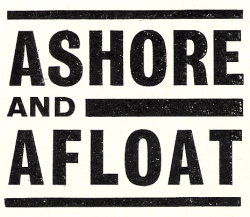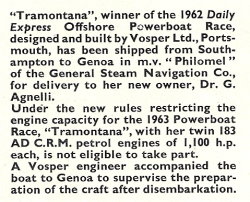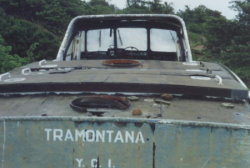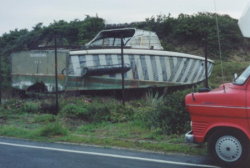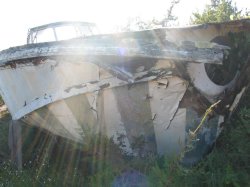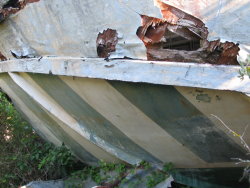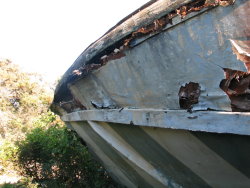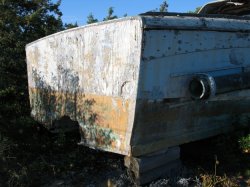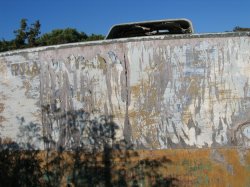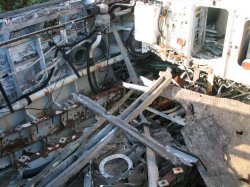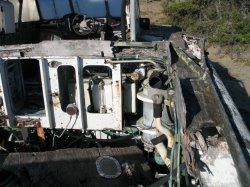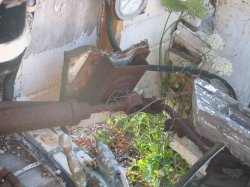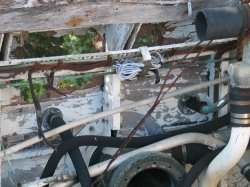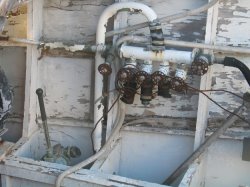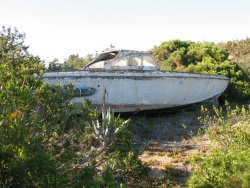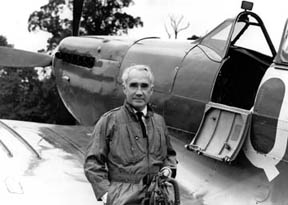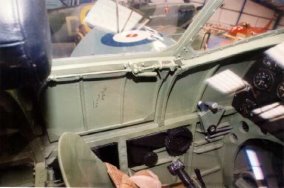Tramontana 1962
| Named after one of the strong Mediterranean winds, that sweeps down from the northern mountains at a moments notice, Tramontana certainly lived up to her name. She was the largest at 42ft and the most powerful, with twin Italian CRM petrol engines rated at a total of 2308hp, entry in the 1962 Cowes Torquay race and a beautiful beast too in her Mid green and white racing colours. Designed by Peter Du Cane, in mini MTB style, built by the all powerful Vosper’s in the Portchester yard this was Stockbroker Dick Wilkins patriotic foray into powerboat racing to make sure the Beaverbrook Trophy stayed in Britain. She was commissioned from Vosper’s at the boat show on New Years day and was completed 8 months later! Mr Wilkins was enticed into the sport by Tommy Sopwith winner of the first race in 1961, he had been Tommy’s backer and patron in his sports car racing days and although the owner of Tramontana left the driving to the team of Jeffrey Quill (please see obituary below) and Don Robertson. 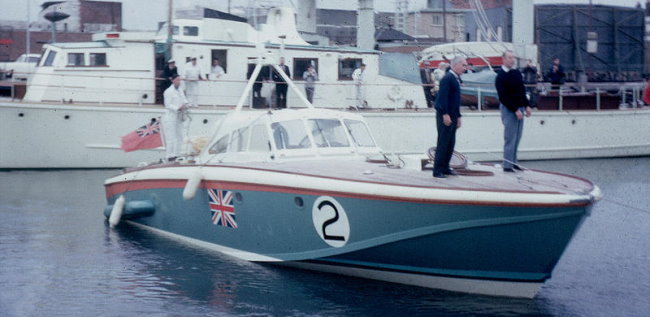 Tramontana Jeffrey Quill is on left on foredeck with D. Robertson on the right. Sam Hutchings who built her is in white Picture taken in Camber Docks, Portsmouth. Courtesy Graham Stevens. During her testing Tramontana was first seen with a full framed
The 1962 Cowes Torquay ran on a new lengthened course of 170miles and Behind her came 2 Americans Sam Griffith in Blue Moppie and little Tramontana’s victory, proved to those who questioned her
Tramontana was last seen in 1990 a few mile’s south of Anzio, in Italy. Above are some pictures of the sorry Since posting this article further information
Photos courtesy Giacomo Vitali,webmaster of The Independent, March 5th 1996 by March 5th 1996 marked the diamond jubilee of the March 5th 1996 marked the diamond jubilee of the first flight of the immortal Supermarine Spitfire, from Eastleigh aerodrome, Southampton. Jeffrey Quill, the second man to fly the aircraft (after Vickers’ chief test pilot, “Mutt” Summers), who took over as chief test pilot and later test-flew every mark of Spitfire, and whose name will for ever be linked with R.J. Mitchell’s masterpiece, died last month. As President of the Spitfire Society, which is closely involved with the celebrations, Quill had been looking forward to the event. Quill was born at Littlehampton in Sussex in 1913, the youngest of five children. In 1926 he began his secondary education at Lancing College, which overlooks Shoreham aerodrome. The constant aerial activity overhead quickened the already air-minded Quill’s resolve to take a non-commissioned career in the Royal Air Force long before he left Lancing in 1931. At 181/2 Quill was accepted into the RAF as an Acting Pilot Officer. He learned to fly on Avro Tutor biplanes and went solo in the remarkably short time of 5 hours 20 minutes (9 hours being regarded as the norm). He graduated on to Siskin IIIA advanced trainers, and his flying ability was assessed as “exceptional”. In September 1932 he joined No 17 Squadron RAF at Upavon, where he began flying Bristol Bulldog fighters. He flew as often as possible in order to familiarise himself with the aeroplane, practising aerobatics and flying in cloud. He wrote later, “Unless aerobatics were practised assiduously to the point where one was familiar with every conceivable combination of speed and altitude of which the aircraft was capable, one was not master of the aeroplane. Therefore a day would come when the aeroplane decided that it was in charge instead of the pilot, and that would be the last day. I never had cause to modify that view, and I kept my aerobatics well honed to the day of my last flight as a pilot.” This discipline was to stand Quill in good stead for his future career as a test pilot. While still at Lancing Quill had attended the famous RAF Display at Hendon, never perhaps dreaming that he would soon participate. He did so on 24 June 1933, taking part in a mock bombing attack. Quill’s aptitude and penchant for flying in all weathers suited his posting to the Meteorological Flight at Duxford. There, flying open-cockpit Siskins, the unit made twice- daily scheduled flights (except on Sundays) up to 25,000ft to collect data for weather reports. After Quill took command of the flight in November 1934 he and his team managed to fly every “slot” for a whole year, regardless of “unflyable” weather, without missing a flight. For this achievement Quill was awarded the Air Force Cross. On one occasion, when letting down through cloud, his Siskin hit the ground very hard but in perfect landing attitude, bounced over a hedge and overturned, pushing Quill’s head forward on to the cockpit coaming (its raised border). Had he not already received a broken nose from a boxing accident he would have qualified for the “Siskin nose” – a characteristic of many pilots of the period. In January 1936 Quill joined Vickers (Aviation) Ltd as assistant to its chief test pilot, “Mutt” Summers. His initial task was the testing of the Wellesley bomber, and it was while flying a production Wellesley that Quill had a narrow escape. The 74ft 7in-span bomber refused to recover from a spin and at 3,000ft Quill decided to bale out. As he descended, the spiralling bomber seemed intent on slicing the pilot with its wings; but he landed safely not far from the Kingston bypass. Quill’s long association with the Spitfire began in earnest when he made his first flight in the prototype on 26 March 1936. There was some rivalry with Hawker, whose Hurricane had first flown four months earlier and Quill’s priority was to get the Spitfire cleared for acceptance by the RAF. A thoroughbred from the start, the Spitfire nevertheless needed a great deal of work before it was deemed safe for young RAF pilots to fly, and did not enter squadron service until July 1938. However, developed through many marks and variants, the Spitfire remained a first-line fighter throughout the war. During this entire period Quill was in charge of development and production flying, a job that he took very seriously – so seriously that he felt he must obtain first-hand combat experience. During August- September 1940 he was temporarily released to join No 63 Squadron at RAF Hornchurch, privately hoping that it would be a permanent appointment. On 16 August he shot down an Me109 and two days later he shared a victory over Heinkel He 111. His combat days were short-lived, but they made Quill all the more determined to make the Spitfire an even better fighting machine.
Jeffrey Quill with Spitfire AB910 in June 1966 Cockpit of Supermarine Spitfire – note Jeffery Quill’s signature on the panel In 1942 the Luftwaffe’s Focke Wulf Fw190 was gaining the edge over Allied fighters, and it was an urgent priority to capture an example. For a while Quill was on standby to be taken to France in order to hijack a Fw190 back to England. Fortunately an example was delivered to the RAF on a plate in the meantime, when a disorientated German pilot landed at a Welsh airfield by mistake. With the introduction of the navalised Spitfire, the Fleet Air Arm suffered enormous losses through deck-landing accidents. In the space of three days one force of 106 Seafires was reduced to 64 serviceable aircraft: something had to be done. Quill duly spent five months with the Navy, during which time he made 75 deck landings. The distinguished naval test pilot Capt Eric “Winkle” Brown later wrote, “{Quill} was an inspired choice, as he had the analytical mind of a superb test pilot trained to find answers to any flight problem.” Equally importantly, he could explain testing problems to his team in language which everyone could understand. By the end of the war Quill had personally test flown all 50-odd variants of Spitfire and Seafire. The rapid increase in performance, armament and all-up weight produced a never-ending stream of design changes, most of which tended to be detrimental to handling qualities and affected the Spitfire’s aesthetics. But, as Quill remarked, “We were trying to produce the most effective flying machine, not the most elegant flying machine.” His personal favourite mark, from a pure flying point of view, was the Spitfire VIII, with standard wings. Quill continued as chief test pilot after the war, when Vickers – ever on the cutting edge of development – produced Britain’s third jet aircraft, the Attacker. On 27 July 1946, Quill made the first flight, from Boscombe Down, and continued to undertake the testing until, one day the following June, he passed out at about 40,000ft. Fortunately he recovered at about 10,000ft in time to land safely. Quill had been flying continually for 16 years, often at high altitude and without oxygen; he was tired and unwell, and he knew that his career as a test pilot was over. He handed the reigns to Mike Lithgow and prepared himself to fly a desk. He had logged more than 5,000 flying hours in nearly 100 different types of aircraft. Quill continued to fly, delivering Spitfires 22s to Cairo and Attackers to the Royal Pakistan Air Force. For many years he kept his hand in with the Spitfire, flying a Mk V at airshows, his aerobatic displays indicating that the master had not lost his touch. His last flight in a Spitfire was made on 16 June 1960, 30 years after his first flight in the prototype. Afterwards he recalled, “As I climbed out of the cockpit, I had that feeling of sadness of bidding farewell to an old friend.” The desk flying began in 1948, with Vickers-Armstrong. After the formation of the British Aircraft Corporation Quill became involved with the Jaguar programme from its inception and became director of the Anglo-French company Sepecat. He was in at the start of the tri-national Multi-Role Combat Aircraft (Tornado) programme in 1969 and became Director of Marketing in Panavia until retiring in 1978.
Outside flying, Quill’s interests extended to sailing and powerboat racing. In 1962 he and his friend Lt-Cdr Don Robertson, a former test pilot with Supermarine, won the Daily Express offshore powerboat race in Tramontana, a wooden Vosper-built craft powered by two Italian 37-litre engines, The following year the pair finished third in Tramontana II. In 1983 Quill published his excellent and absorbing book Spitfire: a test pilot’s story, dedicated to the pilots who flew and fought in the Spitfire. His second book, Birth of a Legend: the Spitfire, co-written with Sebastian Cox, was published in 1986. Quill was passionately interested in English literature, believing the English language to be “the greatest medium of human communication”. Shortly before his death he had almost completed an anthology of quotations, mostly from English and Scottish writers, entitled Other Men’s Thoughts. Jeffrey Quill was a modest, conscientious and talented man, admired, respected and liked by those fortunate enough to know him. A cheerful man with a sense of humour, he was an inspiration to those who worked with him and a hero to thousands who watched his career from the touchline. Jeffrey Kindersley Quill, aviator: born Littlehampton, Sussex 1 February 1913; married three times (three daughters); died Andreas, Isle of Man 20 February 1996. |

